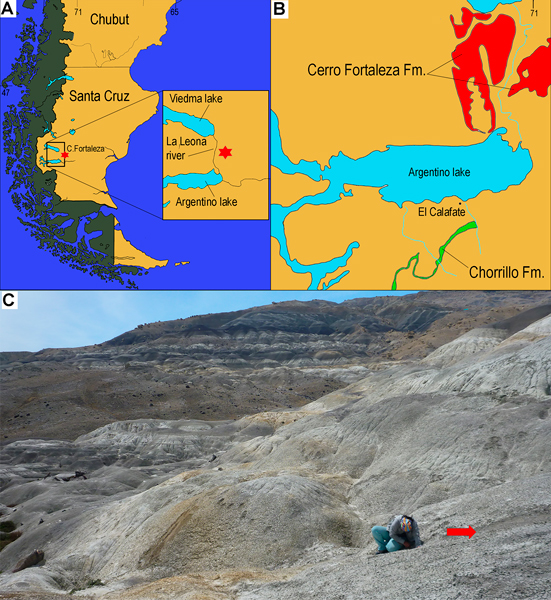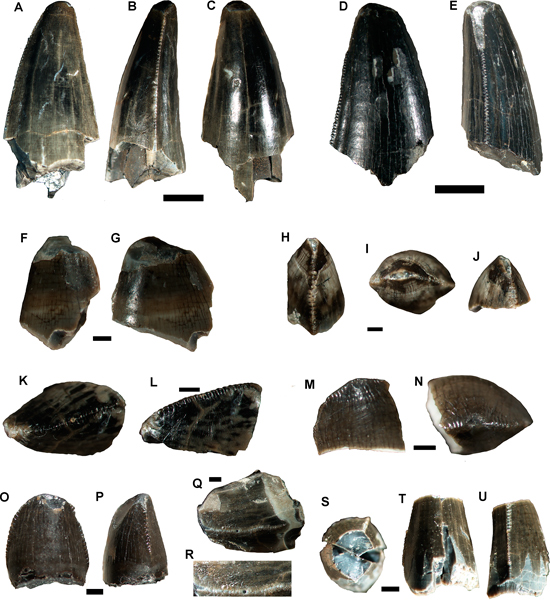Plotting the Fauna of Late Cretaceous Patagonia
Scientists now know that during the Late Cretaceous (Campanian to Maastrichtian), southern Patagonia was home to ankylosaurs and that predatory abelisaurids competed with terrestrial crocodyliforms when it came to scavenging the carcases of giant Titanosaurs.
Researcher have examined fossilised teeth and osteoderms (bony plates and scales embedded in skin) collected from a small area of Upper Cretaceous deposits from the Cerro Fortaleza Formation in Santa Cruz province and used these fossils to piece together an archosaur dominated palaeocommunity.

Teeth from Abelisaurids, Titanosaurs and Ankylosaurs
The dinosaur fauna of the Cerro Fortaleza Formation is very poorly known with only a few dinosaurs named and described, such as the giant titanosaur Dreadnoughtus schrani. However, researchers who included scientists affiliated to CONICET as well as a researcher from Seoul National University (South Korea), have published a paper in the on-line, open access journal PLOS One reporting on the discovery of several very worn and broken teeth that along with fossil osteoderms have enabled the research team to reconstruct the fauna that once roamed this ancient landscape.

To read Everything Dinosaur’s blog post about the discovery of the huge titanosaur Dreadnoughtus: A Little Detail on a Big Dinosaur – Dreadnoughtus.
The Cerro Fortaleza and Chorrillo Formations
Lying some 100 miles (160 kilometres) to the south of the Cerro Fortaleza Formation exposures that yielded the teeth and osteoderm fossils, the Chorrillo Formation is also regarded as an important source of dinosaur fossils. Palaeontologists are not sure of the temporal relationship between these dinosaur-fossil-bearing units, although it has been postulated that the Chorrillo Formation is slightly older. Both units have provided evidence of titanosaurs, theropods and ornithopods, but up to now only the Chorrillo Formation had provided evidence of ankylosaurs. Whilst working at the Cerro Fortaleza locality in December 2016, field team members discovered several isolated osteoderms and a single, very worn tooth thus confirming the presence of armoured dinosaurs in the Cerro Fortaleza Formation too.
Whilst it is difficult to identify a specific type of ankylosaur from just skin scales and a single tooth, the researchers postulate that these fossils represent a nodosaurid.

The Dinosaurs of the Cerro Fortaleza Formation
The researchers were able to confirm the presence of a large abelisaurid theropod and an ankylosaur based on the fossil teeth. Very worn and broken titanosaur spp. teeth were also recorded. The types of dinosaurs that lived in the area represented by the Cerro Fortaleza Formation were similar to those reported from the Chorrillo Formation, although the two populations were very probably made up of different genera.
Intriguingly, evidence of hadrosaurs has been reported from the Chorrillo Formation, as yet no fossils that could be assigned to the Hadrosauridae have been reported from the Cerro Fortaleza Formation.

Crocodyliforms Competing with Carnivorous Dinosaurs
In addition to the dinosaur fossils, the researchers found a total of 9 broken teeth which they assigned to the Peirosauridae family. Peirosaurids are an extinct group of terrestrial crocodyliforms, not closely related to modern crocodilians and seemingly confined to Gondwana. Their upright gait and different shaped teeth (heterodont teeth) indicate that these archosaurs may have had a more varied diet than the carnivorous dinosaurs.
Most of the fossils found represent peirosaurid teeth (75%) and this suggests that there were more crocodyliforms present in the area than dinosaurs. The peirosaurid teeth represent the most southerly distribution of this type of archosaur recorded to date and since the teeth do not match those of Colhuehuapisuchus lunai which is known from Chubut Province to the north, this suggests at least two taxa of peirosaurids present in southern Patagonia during the Late Cretaceous.

The ankylosaur fossils from Cerro Fortaleza and Chorrillo formations, indicate that armoured dinosaurs lived in the region of southern South America during the Late Cretaceous. These fossils although fragmentary help to fill a gap in the fossil record between Antarctica and central-northern Patagonia. Thanks to this research the Late Cretaceous dinosaur record in southern South America has been improved.
The scientific paper: “A Late Cretaceous dinosaur and crocodyliform faunal association–based on isolate teeth and osteoderms–at Cerro Fortaleza Formation (Campanian-Maastrichtian) type locality, Santa Cruz, Argentina” by Ariana Paulina-Carabajal, Francisco T. Barrios, Ariel H. Méndez, Ignacio A. Cerda and Yuong-Nam Lee published in PLOS One.
The Everything Dinosaur website: Dinosaur Toys.

